|
Read more :
|
|
|
|
Sandžak :
|
|
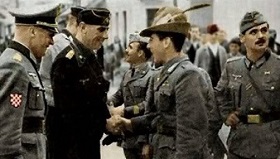
|
|
The Sandžak was from the April, 29th, 1941 for 6 months part of the Independent State of Croatia.
At this date a stamp set, limited to 99 sets, was issued and given to the some members of the croatian customs members and Ustaša (all croatian muslims).
To honour this annexion, local patriots from the
Sandžak who haven´t forgot this event have issued a set of 24 stamps with landscape-motives from the Sandžak at April, 29th, 2024.
[ READ MORE ] [ BUY HERE ]
|
|
|
|
|
|
Prinz Eugen Gau :
|
|
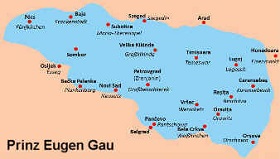
|
|
Before the war III. Reich against the in theeses days existing Kingdom of Yugoslavia, the Germans threatened the Hungarians that if they did not participate in that war, the Volksdeutsche would declare a German state at the territory of Bačka, Banat and eastern Syrmia all the way to Belgrade. That German state was supposed to be connected with a corridor that would go partly around the Danube river to the territory of III. Reich, that is, to the Slovenian Prekomurje, which was then part of III. Reich.
After the proclamation of the Independent State of Croatia April 10, 1941 this plans didn´t stop and the Volksdeutsche planed the proclamation of that state at the birthday of Adolf Hitler at April 20, 1941. They had prepared 3 stamps with overprints on hungarian stamps, but the III. Reich didn´t support this plans, because they don´t want to have problems with the new state, the Independent State of Croatia and also not with Hungary.
The Hungarians were afraid of a possible realisation of such a exteritorial german territory and annexed first the Bačka at the April 11, 1941 and some days later Međimurije of the Independent State of Croatia at the April 16, 1941 so that a corridor between a possible "Prince Eugen Gau" and the III. Reich couldn´t be realized without a war between the Allies Hungary and the III. Reich.
[ READ MORE ] [ BUY HERE ]
|
|
|
|
|
|
Prinz Eugen Division :
|
|
The Volksdeutsche from the Independent State of Croatia issued overprints on German stamps of the “Day of Wehrmacht” in 1943 and 1944, which was given to the new members of the division "Prinz Eugen".
[ READ MORE ] [ BUY HERE ]
|
|
|
|
|
|
”Bosniaks” are Croats!
|
|
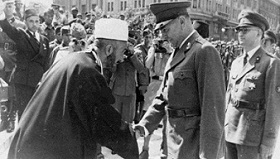
|
|
Regardless of the fact that the Croatian Muslims from Bosnia only reinvented themselves as a separate nation in 1991, they remain genetically Croats. This is not only evidenced by the largest genetic institute in Vancouver (Canada) but also by countless statements from Croatian Muslims from Bosnia over the past centuries.
[ READ MORE ]
|
|
|
|
|
|
Kuna and Banica :
|
|

|
|
We offer you very hard to find coins of the Independent State of Croatia and the 2nd exile.
In 1991 the german military camaradery “Handschar” issues coins in various metals in a limitation of only 200 coins :
- 25 Banica, 23,3 mm : 50 years of Sandžak annexion
- 50 Banica, 24,3 mm : Croatian warrior
- 1 Kuna, 25,7 mm : Handžar
- 1 Kuna, 25,7 mm : Coat of arms of Handžar, Kama and Prinz Eugen
- 2 Kuna, 28,0 mm : HOS
- 2 Kuna, 28,0 mm : Croatian State Labour Service
- 5 Kuna, 30,0 mm : Marija Oršić
- 5 Kuna, 30,0 mm : Frane Tente
- 10 Kuna, 32,0 mm : Beware of Četniks and Partisans
- 10 Kuna, 32,0 mm : Black Legion and Jure Francetić
- 50 Kuna, 39,0 mm : Poglavnik Dr. Ante Pavelić
Read all about the currency of the Independent State of Croatia : [ HERE ] [ BUY HERE ]
|
|
|
|
|
|
The truth about the victims :
|
|
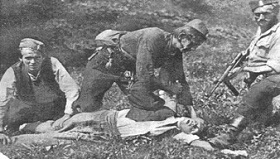
|
|
Enough of the Serbian lies: before World War II and after World War II, there was a census in the Serbian-dominated Kingdom of Yugoslavia and in the Serbian-dominated communist Yugoslavia, which showed 1,024,000 more Serbs and
1,230,000 fewer Croats, as well as 140,000 fewer Germans.
Read more : [ HERE ]
|
|
|
|
|
|
|
|
|
|
|
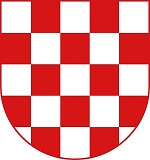 |
|
|
|
|
|
Currency of the Independent State of Croatia : Kuna and Banica.
|
|
|
|
The name Kuna for the permanent Croatian currency was chosen because of the significant role of the marten fur in Croatian monetary and fiscal history. The history of the name of the monetary unit of Croatia begins with the kuna fur as a means of natural payment, then the Kuna becomes an accounting monetary unit and, finally, money in the modern sense.
The marten´s fur served as a means of paying the tax called kunovina or marturina in medieval Slavonia, Primorje and Dalmatia; from the first half of the 13th century until almost the end of the 14th century, the figure of the marten appeared on Croatian coins called Banovac (minted in Pakrac). The Kuna was the potential money of Banovina Hrvatska.
|
|
|
|
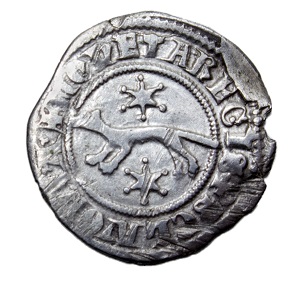
|
We find the first mention of natural payment in marten skins when paying a tax (tribute) in the amount of 40 marten skins (Osor on Cres) or 50 marten skins (Beli, also on Cres).
The tribute was collected by the Venetian Doge Otto Orseolo in 1018 in Osor.
From 1941 to 1945, the Kuna became the currency of the Independent State of Croatia. Italian Lira banknotes and German Reichskreditkassenschein banknotes were temporarily in circulation until 31.12. 1941, i.e. 23.8. 1941, and after that the Kuna was the only and exclusive legal tender.
The abbreviation for Kuna was Kn.
Srboje Klasić, a difficult "(h)istorian" without a history, made himself an idiot, because he claims that the Kuna is Ustasha money, minted in 1941. That difficult "historian" who doesn't know about history has probably never heard or seen 5 Kunas minted in 1934 (see below) and apparently not even for Banovac from the middle of the 13th century.
|
|
|
|
|
|
In 2004, an international symposium was held in Zagreb with the theme 'Religions and money'. The following year, the organizer of the symposium, the Philosophical and Theological Institute of the Society of Jesus, published the proceedings of the symposium.
It also published the work of Ševko Omerbašić, the former mufti of Zagreb for many years and the president of the Mešihat of the Islamic Community in Croatia, under the title 'Islam and money'.
|
|
|
|
Here is the part related to our Kuna :
"Finally, allow me to convey to you a part of a report by the travel writer Abu Hamid al-Garnati from long ago, in 1154, in which he reports on a three-year stay in Hungary (Unkaria) among the Ismaelian and Kalizi Muslims there. In his manuscript, which was discovered in 1952 in the famous manuscript collection of the 'Real Academia de la Historia' in the Escorial in Madrid, and was translated, edited, edited and published in 1953 by the Spanish orientalist C. E. Dubler, Abu Hamid describes in detail the money that firmly connected with the name of our Kuna coin. Here is what Abu Hamid says about that money: 'Arriving in the land of the Croats, I found out that it is a vast and rich country. I have seen many hives of bees, fields of barley and wheat, and many orchards of apples, and I have never eaten bigger, tastier, and more delicious apples. Food is very cheap. As a means of payment in mutual trade, they use marten skin, with shaved hair, which is not used for anything else, nor is it usable for anything else. The skin of the marten must be complete with the head, front and hind paws and only as such is correct. Eighteen such skins are worth one silver Dirham, according to their exchange rate. The skin is lined with strong thread and is called "kundža". One such foreskin buys a piece of bread, enough to feed a grown man. With them, everything is bought and sold for these skins, concubines, slaves, servants, gold, silver, food and all other necessities. This money is not valid in any other country. When the leather money is worn, they are taken for repair to a craftsman who sews up the torn skins with strong leather thread. Black lead beads are hung on the edge threads, and then they are sealed with a red royal seal. A seal is stamped on each skin. Skins repaired in this way are put into circulation and no one can refuse them in the trade."
In addition to the Kuna as a means of payment for the Croats, Abu Hamid describes their country, a large black river (Danube) whose water is drinkable and sweet, and in which there are more water snakes than fish, impenetrable forests where different and strange animals live, beavers around the rivers whose he takes the skin to Bulgaria and sells it on the markets, and furs are made from it. Abu Hamid describes the Croats as very honest and hardworking people.
Arab travel writers mostly went on their long journeys on behalf of the authorities in Baghdad or Cordoba. They found donors among the traders who paid for their journeys, and they in turn were obliged to describe in detail the countries and peoples in which they stayed, their economy, agriculture and natural resources. It was the same with Abu Hamid.'
And now Srboje Klasić?
|
|
|
|
|
|
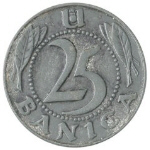
|

|
25 Banica :
Sample. 1941. Zinc
Different metals.
The coin was to be released in zinc after World War II.
|

|
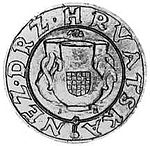
|
25 Banica :
Sample from the year 1941. with other backside.
Manufactured in different metals.
|
|
|
|
|
|
|
|
|
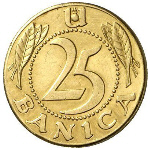
|

|
25 Banica :
Sample. 1941. Gold.
The coin was to be released in zinc after World War II.
|
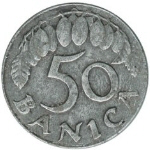
|
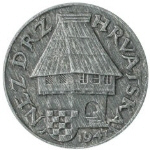
|
50 Banica :
Sample 1941. Zinc.
The coin was to be released in zinc after World War II.
|
|
|
|
|
|
|
|
|
|
|
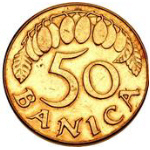
|
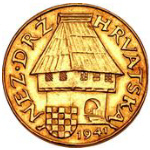
|
50 Banica :
Sample. 1941. Gold.
The coin was to be released in zinc after World War II.
|

|
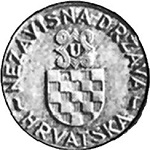
|
1 Kuna :
Sample. 1941.
|
|
|
|
|
|
|
|
|
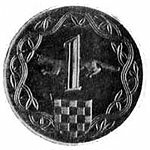
|

|
1 Kuna :
Sample. 1941.
Manufactured in different metals.
|

|
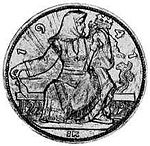
|
1 Kuna :
Sample. 1941.
Manufactured in different metals.
|
|
|
|
|
|
|
|
|
|
|
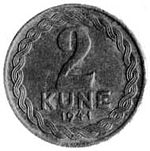
|

|
2 Kuna :
Zinc. 1941.
The only coin (apart from gold coins) that was used in the Independent State of Croatia.
|
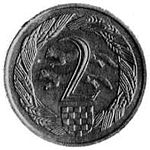
|

|
2 Kuna :
Zinc. 1941.
Sample.
|
|
|
|
|
|
|
|
|

|
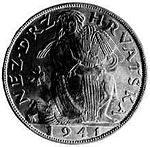
|
2 Kuna :
Zinc. 1941.
Sample.
|

|

|
2 Kuna :
Zinc. 1941.
Sample.
|
|
|
|
|
|
|
|
|
|
|
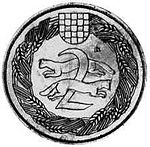
|

|
2 Kune :
Zinc. 1941.
Sample.
|
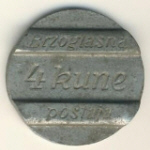
|

|
4 Kune :
Telephone coin. 1941.
|
|
|
|
|
|
|
|
|
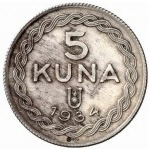
|
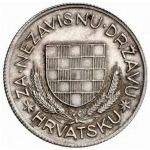
|
5 Kuna :
Issued in exile in 1934, 7 years before the establishment of the Independent State of Croatia. manufactured in Berlin / Germany.
Silver (900/1000), 23 mm, 4.34 g.
There are also coins made of bronze, nickel and copper.
|
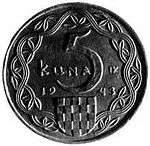
|
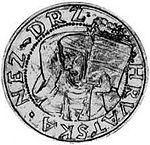
|
5 Kuna :
Zinc. 1941.
Sample.
|
|
|
|
|
|
|
|
|
|
|

|
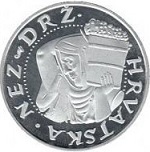
|
5 Kuna :
Recent fake!
|
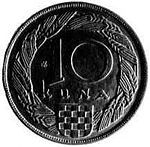
|
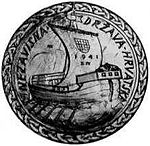
|
10 Kuna :
Sample. 1941.
Manufactured in different metals.
|
|
|
|
|
|
|
|
|

|

|
10 Kuna :
Recent fake!
|

|
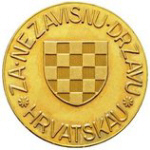
|
50 Kuna :
Private edition after World War II! No issue of the government-in-exile of the Independent State of Croatia!
Gold.
|
|
|
|
|
|
|
|
|
|
|
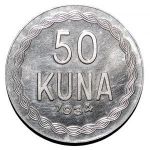
|
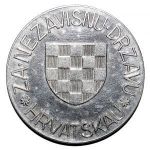
|
50 Kuna :
Private edition after World War II! No issue of the government-in-exile of the Independent State of Croatia!
Silver.
|
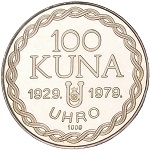
|
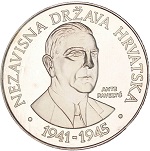
|
100 Kuna :
Issued by the Ustasha-emigration in the year 1979.
Silver.
|
|
|
|
|
|
|
|
|
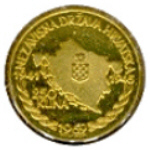
|
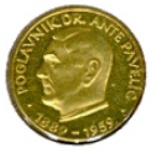
|
250 Kuna :
Issued by the Ustasha-emigration in the year 1959.
Silver.
|
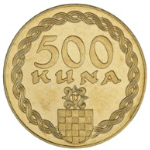
|
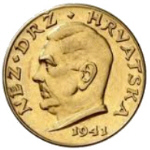
|
500 Kuna :
1941.
Gold.
Made in the Croatian State Mint in Zagreb in 1941.
According to the latest literature, with which most experts agree, no more than 19 pieces were made, and a smaller number are today in private collections (value around 7,500 €).
The literature mentions the production of 450 gold coins, newly minted, but these are copies from 1948, which are smaller and 1g lighter, and in the catalog the value is 3,000 €.
|
|
|
|
|
|
|
|
|
|
|
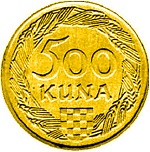
|
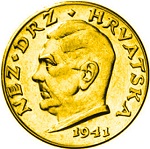
|
500 Kuna :
Without “U” over national coat of arms.
1941.
Gold.
|
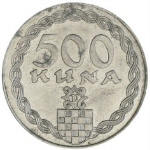
|
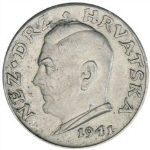
|
500 Kuna :
1941.
Silver.
|
|
|
|
|
|
|
|
|

|

|
500 Kuna :
Without “U” over national coat of arms.
1941.
Silver.
|

|
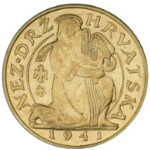
|
500 Kuna :
1941.
Gold.
|
|
|
|
|
|
|
|
|
|
|

|
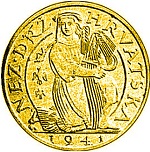
|
500 Kuna :
Without “U” over national coat of arms.
1941.
Gold.
|

|

|
500 Kuna :
1941.
Silver.
|
|
|
|
|
|
|
|
|

|

|
500 Kuna :
Without “U” over national coat of arms.
1941.
Silver.
|
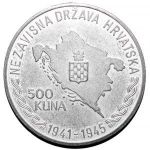
|
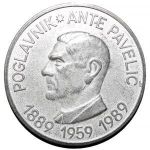
|
500 Kuna :
1989. Silver (1000/1000), 25 g, 40 mm.
The coin was issued by Višnja Pavelić, daughter of the Poglavnik Dr. Ante Pavelić in Madrid.
|
|
|
|
|
|
|
|
|
|
|
|
|
Independent State of Croatia : coins of the Handschar division.
|
|
|
|
The Veteran Association “Handschar” (Handžar) has published in the year 1991 five different coins in various metals :
|
|
|
25 Banica, front side :
|
25 Banica, back side :
|
|

|

|
|
Picture soon ...
|
Picture soon ...
|
|
|
The 25 Banica coin (23,3 mm) which you can see at the left-hand-side is limited to only 200 coins :
- 40 in patinated Brass.
- 40 in “Old Silver”-Steel
- 40 in Nickel
- 40 in patinated Copper.
- 30 in Silver
- 10 in Gold
Motive : 50 years of Sandžak annexion.
Buy here :  . .
|
|
|
|
50 Banica, front side :
|
50 Banica, back side :
|
|

|

|
|
Picture soon ...
|
Picture soon ...
|
|
|
The 50 Banica coin (24,3 mm) which you can see at the left-hand-side is limited to only 200 coins :
- 40 in patinated Brass.
- 40 in “Old Silver”-Steel
- 40 in Nickel
- 40 in patinated Copper.
- 30 in Silver
- 10 in Gold
Motive : Croatian warrior.
Buy here :  . .
|
|
|
|
1 Kuna, front side :
|
1 Kuna, back side :
|
|

|

|
|
Picture soon ...
|
Picture soon ...
|
|
|
The 1 Kuna coin (25,7 mm) which you can see at the left-hand-side is limited to only 200 coins :
- 40 in patinated Brass.
- 40 in “Old Silver”-Steel
- 40 in Nickel
- 40 in patinated Copper.
- 30 in Silver
- 10 in Gold
Motive : Handžar.
Buy here :  . .
|
|
|
|
1 Kuna, front side :
|
1 Kuna, back side :
|
|

|

|
|
Picture soon ...
|
Picture soon ...
|
|
|
The 1 Kuna coin (25,7 mm) which you can see at the left-hand-side is limited to only 200 coins :
- 40 in patinated Brass.
- 40 in “Old Silver”-Steel
- 40 in Nickel
- 40 in patinated Copper.
- 30 in Silver
- 10 in Gold
Motive : Coat of arms of Handžar, Kama and Prinz Eugen.
Buy here :  . .
|
|
|
|
2 Kuna, front side :
|
2 Kuna, back side :
|
|

|

|
|
Picture soon ...
|
Picture soon ...
|
|
|
The 2 Kuna coin (28 mm) which you can see at the left-hand-side is limited to only 200 coins :
- 40 in patinated Brass.
- 40 in “Old Silver”-Steel
- 40 in Nickel
- 40 in patinated Copper.
- 30 in Silver
- 10 in Gold
Motive : HOS.
Buy here :  . .
|
|
|
|
2 Kuna, front side :
|
2 Kuna, back side :
|
|

|

|
|
Picture soon ...
|
Picture soon ...
|
|
|
The 2 Kuna coin (28 mm) which you can see at the left-hand-side is limited to only 200 coins :
- 40 in patinated Brass.
- 40 in “Old Silver”-Steel
- 40 in Nickel
- 40 in patinated Copper.
- 30 in Silver
- 10 in Gold
Motive : Croatian State Labour Service.
Buy here :  . .
|
|
|
|
5 Kuna, front side :
|
5 Kuna, back side :
|
|

|

|
|
Picture soon ...
|
Picture soon ...
|
|
|
The 5 Kuna coin (30 mm) which you can see at the left-hand-side is limited to only 200 coins :
- 40 in patinated Brass.
- 40 in “Old Silver”-Steel
- 40 in Nickel
- 40 in patinated Copper.
- 30 in Silver
- 10 in Gold
Motive : Marija Oršić.
Buy here :  . .
|
|
|
|
5 Kuna, front side :
|
5 Kuna, back side :
|
|

|

|
|
Picture soon ...
|
Picture soon ...
|
|
|
The 5 Kuna coin (30 mm) which you can see at the left-hand-side is limited to only 200 coins :
- 40 in patinated Brass.
- 40 in “Old Silver”-Steel
- 40 in Nickel
- 40 in patinated Copper.
- 30 in Silver
- 10 in Gold
Motive : Frane Tente, killed by jugo-serbian occupators of the Independent State of Croatia.
Buy here :  . .
|
|
|
|
10 Kuna, front side :
|
10 Kuna, back side :
|
|

|

|
|
Picture soon ...
|
Picture soon ...
|
|
|
The 10 Kuna coin (32 mm) which you can see at the left-hand-side is limited to only 200 coins :
- 40 in patinated Brass.
- 40 in “Old Silver”-Steel
- 40 in Nickel
- 40 in patinated Copper.
- 30 in Silver
- 10 in Gold
Motive : Beware of Četniks and Partisans.
Buy here :  . .
|
|
|
|
10 Kuna, front side :
|
10 Kuna, back side :
|
|

|

|
|
Picture soon ...
|
Picture soon ...
|
|
|
The 10 Kuna coin (32 mm) which you can see at the left-hand-side is limited to only 200 coins :
- 40 in patinated Brass.
- 40 in “Old Silver”-Steel
- 40 in Nickel
- 40 in patinated Copper.
- 30 in Silver
- 10 in Gold
Motive : Black Legion and Jure Francetić.
Buy here :  . .
|
|
|
|
50 Kuna, front side :
|
50 Kuna, back side :
|
|

|

|
|
Picture soon ...
|
Picture soon ...
|
|
|
The 50 Kuna coin (32 mm) which you can see at the left-hand-side is limited to only 200 coins :
- 40 in patinated Brass.
- 40 in “Old Silver”-Steel
- 40 in Nickel
- 40 in patinated Copper.
- 30 in Silver
- 10 in Gold
Motive : Poglavnik Dr. Ante Pavelić.
Buy here :  . .
|
|
|
|
|
|
In 1991 also a 5 Kuna coin was published, but at the back side are not traditional croatian motives.
At the back-side you can find a motive of the band Depeche Mode and their album “Violator”.
You can´t find at this coins the abbreviation “TKH” for “Truppenkameradschaft Handschar” like at the coins above, but because of the fact that it is produced in the same limitation and the same materials we are sure that this coin was published also from or from the environment of the Veteran Association “Handschar”.
|
5 Kuna, front side :
|
5 Kuna, back side :
|
|

|

|
|
|
The 5 Kuna coin (32 mm) which you can see at the left-hand-side is limited to only 200 coins :
- 40 in patinated Brass.
- 40 in “Old Silver”-Steel
- 40 in Nickel
- 40 in patinated Copper.
- 30 in Silver
- 10 in Gold
Motive : Depeche Mode “Violator”.
Buy here :  . .
|
|
|
|
|
|
|
|
|
Paper money of the Independent State of Croatia :
|
|
|
|

|
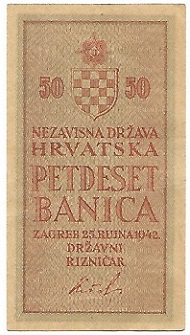
|
50 Banica :
Day of publishing : 25. September 1942.
Size : 44×80 mm
|
|
|
|
|
|
|
|
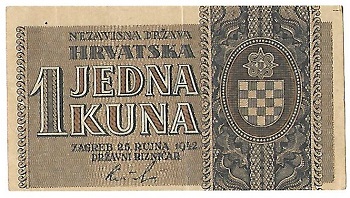
|
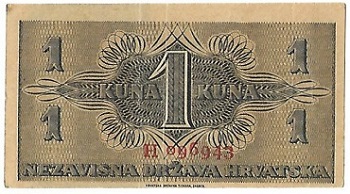
|
1 Kuna :
Day of publishing : 25. September 1942.
Size : 81×44 mm
|
|
|
|
|
|
|
|

|
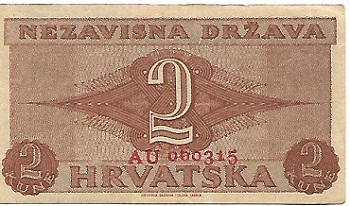
|
2 Kuna :
Day of publishing : 25. September 1942.
Size : 81×44 mm
|
|
|
|
|
|
|
|
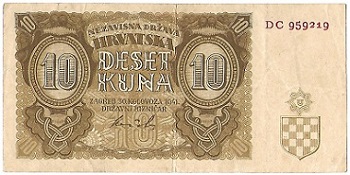
|
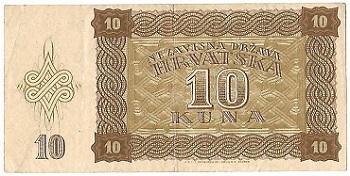
|
10 Kuna :
Day of publishing : 30. August 1941.
Size : 135×68 mm
|
|
|
|
|
|
|
|
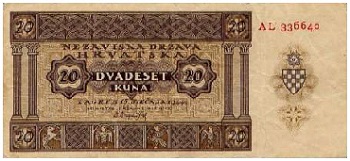
|
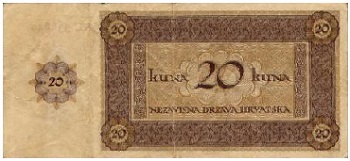
|
20 Kuna :
Dan izdanja : 15. January 1944.
Size : 140×64 mm
|
|
|
|
|
|
|
|

|

|
50 Kuna :
Day of publishing : 15. January 1944.
Size : 144×67 mm
|
|
|
|
|
|
|
|
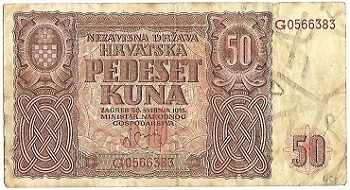
|
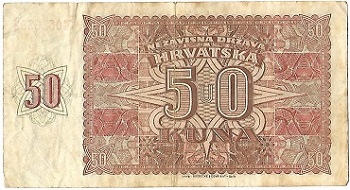
|
50 Kuna :
Dan izdanja : 26. May 1941.
Size : 140×75 mm
|
|
|
|
|
|
|
|
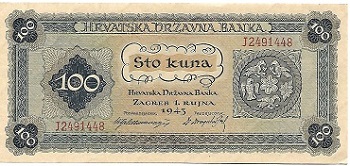
|
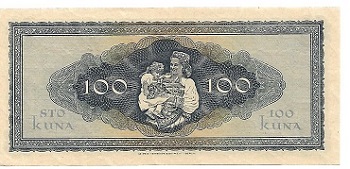
|
100 Kuna :
Day of publishing : 1. September 1943.
Size : 157×73 mm
|
|
|
|
|
|
|
|

|
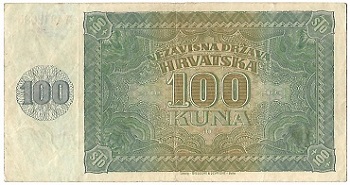
|
100 Kuna :
Day of publishing : 26. May 1941.
Size : 150×80 mm
|
|
|
|
|
|
|
|
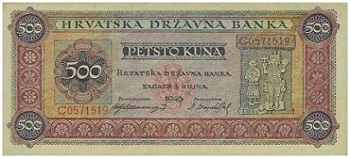
|
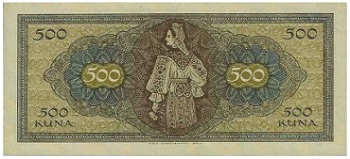
|
500 Kuna :
Day of publishing : 1. September 1943.
Size : 167×76 mm
|
|
|
|
|
|
|
|

|
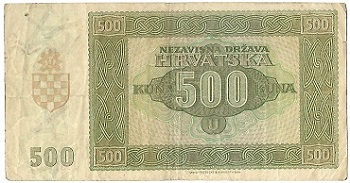
|
500 Kuna :
Day of publishing : 26. May 1941.
Size : 157×84 mm
|
|
|
|
|
|
|
|
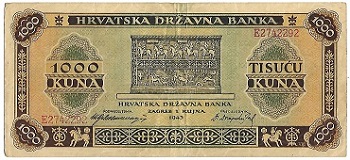
|
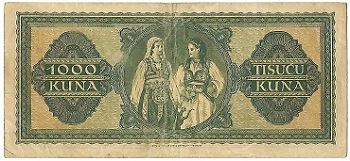
|
1000 Kuna :
Day of publishing : 1. September 1943.
Size : 176×80 mm
|
|
|
|
|
|
|
|
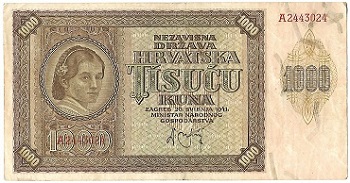
|
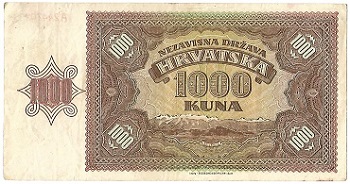
|
1000 Kuna :
Day of publishing : 26. May 1941.
Size : 137×68 mm
|
|
|
|
|
|
|
|
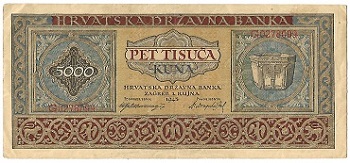
|
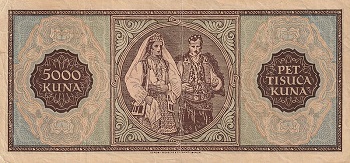
|
5000 Kuna :
Day of publishing : 1. September 1943.
Size : 185×85 mm
|
|
|
|
|
|
|
|
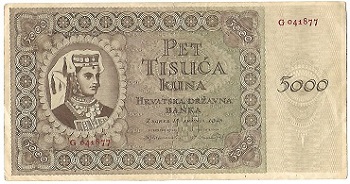
|
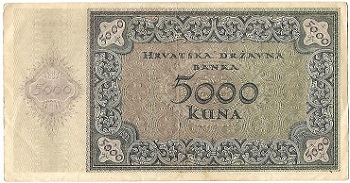
|
5000 Kuna :
Day of publishing : 15. July 1943.
Size : 180×95 mm
|
|
|
|
|
|
|
|
|
|
Paper money of the Independent State of Croatia : local paper-money for Zagreb.
|
|
|
|
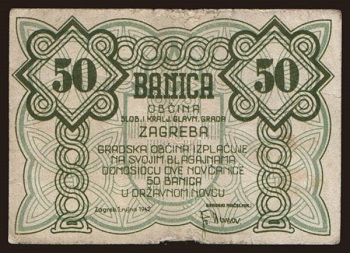
|
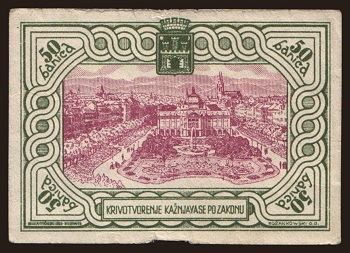
|
50 Banica :
Day of publishing : 1. September 1942.
Size : 69×48mm
|
|
|
|
|
|
|
|

|

|
50 Banica :
Day of publishing : 1. September 1942.
Size : 69×48mm
|
|
|
|
|
|
|
|
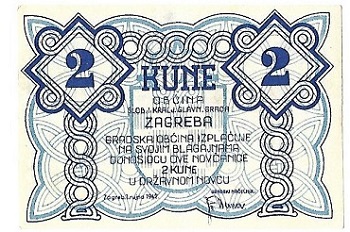
|
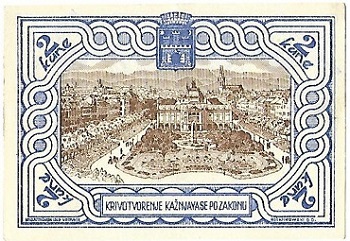
|
50 Banica :
Day of publishing : 1. September 1942.
Size : 69×48mm
|
|
|
|
|
|
|
|
|
|
Paper money of the Independent State of Croatia : group Marić.
|
|
|
|
|
|
|
|
Paper money of the Independent State of Croatia : bakery Albin Hruš.
|
|
|
|
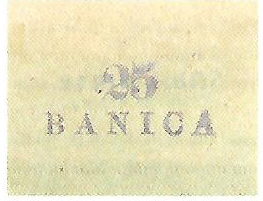
|
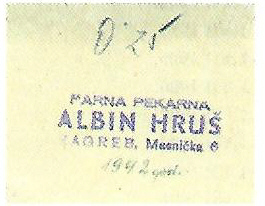
|
25 Banica :
Day of publishing : ???
Size : ???
|
|
|
|
|
|
|
|
|
|
Paper money of the Independent State of Croatia : dairy S. Breber.
|
|
|
|
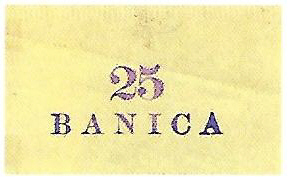
|
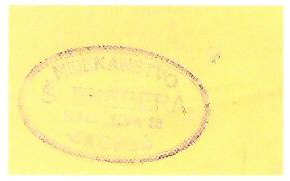
|
25 Banica :
Day of publishing : ???
Size : ???
|
|
|
|
|
|
|
|
|
|
Paper money of the Independent State of Croatia : State Treasury.
|
|
|
|
|
|
|
|
|
|
|
|
Paper money of the Independent State of Croatia : defector legitimacy.
|
|
|
|
|
|
|
|
Paper money of the Independent State of Croatia : Union of Cooperatives of Civil Servants in Zagreb.
|
|
|
|
|
|
|
|
Paper money of the Independent State of Croatia : Ministry of State Treasury.
|
|
|
|
|
|
|
|
|
|
Paper money of the Independent State of Croatia : SS division “Prince Eugen”.
|
|
|
|
|
|
|
|
Coins of the Croatian Naval Legion :
|
|
|
|
The Croatian Naval Legion had the military post number 34437.
|
|
|
|
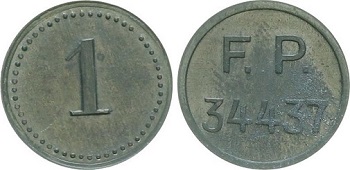
|
Left : 1 Pfennig. Zinc. 1943.
|
|
|
|
|
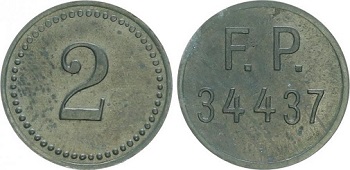
|
Left : 2 Pfennig. Zinc. 1943.
|
|
|
|
|
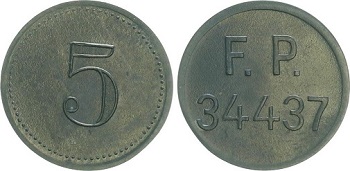
|
Left : 5 Pfennig. Zinc. 1943.
|
|
|
|
|

|
Left : 10 Pfennig. Zinc. 1943.
|
|
|
|
|
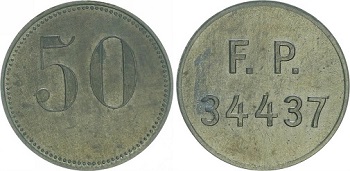
|
Left : 50 Pfennig. Zinc. 1943.
|
|
|
|
|
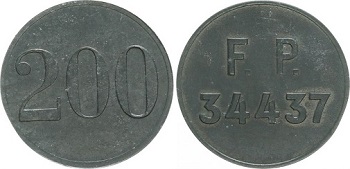
|
Left : 200 Pfennig. Zinc. 1943.
|
|
|
|
|
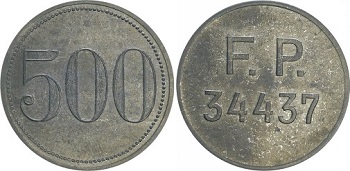
|
Left : 500 Pfennig. Zinc. 1943.
|
|
|
|
|
|
|
|
|